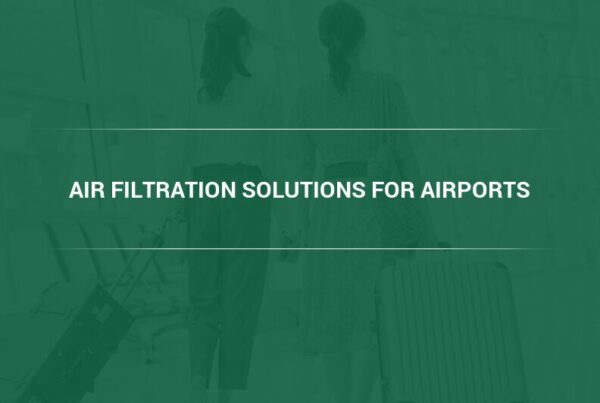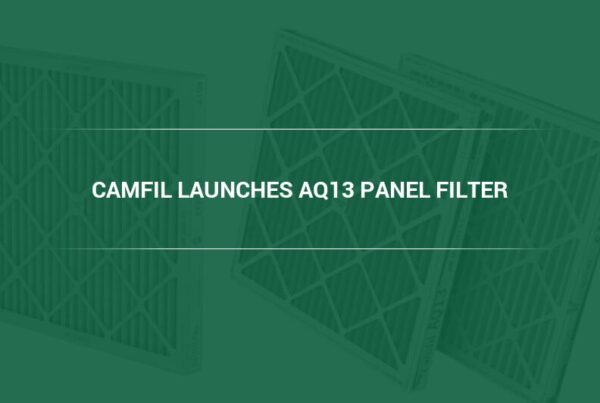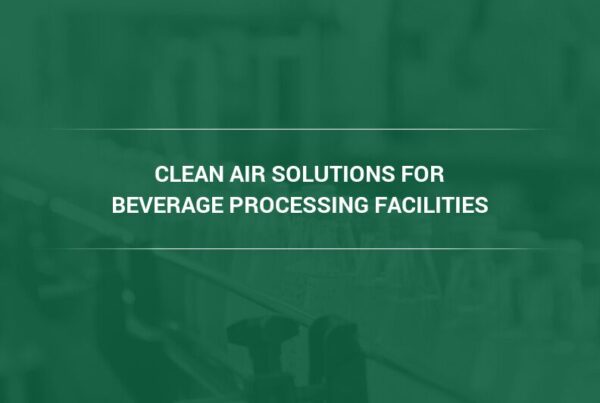The importance of procuring high-quality air filters cannot be overstated. The proper air filters not only ensure the health and well-being of the occupants but also contribute significantly to the building’s energy efficiency and longevity.
Many professionals should be able to understand the technical, environmental, and economic aspects of air filtration equipment, as well as what an HVAC technician will see when installing and replacing filters, to make the best purchasing decisions for their organizations. Professionals involved in air filter purchasing decisions include procurement managers, procurement specialists, buyers, purchasing agents, purchasing managers, supply chain managers, chief financial officers, accounting managers, quality control personnel, quality engineers, and quality managers. Getting all of these professionals up to speed and on the same page about air filter procurement is a challenging task.
Camfil has launched a new series of videos where their Director of Comfort Air, Dave Blackwell discusses the process of air filter procurement for commercial buildings and provides steps for ensuring that you are getting the highest quality filters for your building’s specific needs.
This article will serve as an additional resource for those who are responsible for ensuring the air quality in commercial buildings. In the following sections, we will navigate you through the process of identifying, selecting, and obtaining the highest-quality air filters for your commercial building.
Problem Identification: Why RFQ Doesn’t Work
In most cases, companies use an RFQ (request for quote) to procure air filters. The RFQ process typically involves requesting quotes from multiple suppliers and then comparing them based on price and delivery time. For example, a large corporation purchasing paper goods for numerous facilities across North America may list a need for 5000 boxes of two-ply, soft, facial tissues in two different-sized containers. Suppliers responding to this RFQ would input their price per piece for each size on a spreadsheet included with the RFQ. The assumption is made that the products submitted by all suppliers responding to the RFQ are the same or at least similar enough from a performance perspective that users would be unable to tell the difference.
Unfortunately, many companies currently source air filters the same way. Often, the only requirements listed are the size of the filter, the efficiency (MERV rating) and sometimes the annual quantity is included. The filters are listed on a spreadsheet and the supplier is requested to submit (quote) their best price for each filter size / MERV rating. The assumption is filters submitted by various suppliers are all basically the same, or close in performance. Since the piece price of each filter is the primary factor for the supplier granted the business, a bidding war begins and the lowest bid wins. The company adds up the savings and assumes that by using this commodity-type purchasing procedure to source air filters, they’ve saved the company X% of money.
However, air filters are not commodity products, but highly technical pieces of equipment. While it may be true that there is no significant difference in performance between various types of 2-ply facial tissues, the same cannot be said for air filters of the same depth and MERV rating.
An air filter is just one component (and often one of the lowest priced) in a much larger and more complex HVAC system. However, an air filter can have drastic effects on the overall performance (and therefore, the operational cost) of the entire HVAC system. Poor quality filters that become clogged quickly drive up energy prices and reduce air circulation. Air filters that allow debris to pass through can result in major damage to sensitive HVAC equipment that requires expensive repairs. Sourcing air filters as if they are commodities costs money. It does not save money.
Learn more: How Do Companies Procure Air Filters?
The Technical Nature of Air Filters
Air filters may seem like a simple and straightforward product, but they are actually quite technical in nature. There are various types of air filters available in the market, each with its own unique features and specifications. This makes it difficult for procurement teams to identify and specify the optimum air filter for each HVAC system within their building using a spreadsheet.
Hidden Lifetime Costs of Air Filters
When procuring air filters, it’s crucial to consider more than just the initial purchase price. There are several hidden lifetime costs associated with air filters that are often overlooked, which can significantly impact a company’s budget and the health of building occupants.
- Energy Costs. Air filters directly affect the energy efficiency of your HVAC system. A poor-quality, old, or clogged filter can make the system work harder to maintain air quality and temperature, leading to increased energy consumption and higher utility bills. Look for filters with a 5-Star Energy Cost Index rating for the lowest energy consumption.
- Labor and Replacement Costs. Filter change frequency depends on the quality of the filter and the environmental conditions. Lower-quality filters require more frequent replacements, resulting in higher labor costs. When in-house maintenance staff is used, the lost labor hours could have been reallocated to far more valuable projects. Replacing an air filter also necessitates the disposal of the old filter, which is another expense that needs to be accounted for when assessing lifetime costs.
- Health Implications. The quality of air filters also has direct implications on occupant health. Lower-quality filters allow more pollutants and allergens to circulate in the indoor air, impacting not only the physical health of occupants and employees but also their cognitive functioning and capacity for productivity. Inadequate air filtration therefore leads to additional costs as a result of increased employee sick days and decreased productivity. (Read more: Exploring the Link Between Better Indoor Air Quality and Improved Productivity.)
It’s important to remember that financing for energy usage, contracted maintenance, and employee labor are likely handled by different departments in large organizations, and budgets may be fragmented even further in regional and national companies that operate dozens of buildings in multiple districts.
Because costs are possibly dispersed into different budgets, it can be difficult to see just how much current air filters are costing your company.
Learn more: How Do You Know If Your Air Filters Are Costing You Extra?
Why Cheap Air Filters Need to Be Replaced So Frequently
There are air filters that incorporate an electrostatic charge which essentially functions as a magnet for particulate matter, enhancing particle capture efficiency across all three size ranges. Consequently, manufacturers can assign the filter a higher MERV value after factory testing. However, as the filter accumulates dirt, the charge loses its ability to attract particles, causing a decline in the actual particle capture efficiency of the filter.
A MERV-13 filter, for example, can drop to a particle capture efficiency equivalent to that of a MERV-8 filter within a short period of time, sometimes as little as a month, leaving people and equipment less protected than expected. ASHRAE’s testing standards specify an optional testing method for determining filter efficiency without electrostatic charge. The values determined from this test are MERV-A values. MERV-A-rated filters will retain their rated efficiency across the lifespan of the filter. An easy way to remember the distinction between MERV and MERV-A is to think of the “A” as standing for “actual,” so a filter’s MERV-A rating represents its “actual” efficiency.
Additional Resources for Air Filter Procurement
For those seeking in-depth knowledge and understanding of air filter procurement, the following resources are useful:
- Camfil’s official website provides a range of expert advice, product details, case studies, industry news, and insightful articles.
- Camfil’s YouTube channel provides comprehensive and easily digestible information on a wide array of including cost-efficiency, maintenance, and quality assessment.
Camfil’s Solution for Air Filter Procurement: Focusing on TCO
Understanding the application and performance expectations of each air filter is crucial in making the best-informed decision for your commercial building. Not all air filters are made equal, and it’s important to choose a high-quality air filter that meets or exceeds industry standards and fits the unique needs of each building, which include:
- HVAC System Specifications. Many commercial HVAC systems have shallow tracts to house filters, usually limiting options to one-, two- or four-inch deep air filters. (Learn more: Do All Air Handling Units Use the Same Air Filter?)
- Air Pollution Composition. The location of your building and local air quality, in addition to what indoor air pollutants are being generated inside the building, are important factors to consider when selecting an air filter.
- Air Quality Goals. Each organization’s goals for indoor air quality in their buildings may vary based on recommendations from professional organizations, state regulations, and federal standards.
Once the factors have been considered, the ideal filtration solution will consider the total cost of ownership (TCO) rather than the initial purchasing price of individual filters.
Air filters may seem like a small expense, but they can add up over time. Consider the total cost of ownership when selecting an air filter, including initial purchase price, replacement frequency, and energy efficiency. A lower-priced filter may seem like a bargain, but if it needs to be replaced more frequently or has higher energy consumption, it may end up costing your company more in the long run.
Example Analysis
The following example uses round numbers to illustrate the difference in TCO between an inexpensive commodity filter and a higher-priced technical filter. The figures do not represent real filter or energy prices. For a real-life example of the savings a building-wide filter upgrade can bring, read about how Nashville’s Music City Center decreased labor by 80% and energy consumption by 34% with Camfil air filters.
| Cost Category | Inexpensive Commodity Filter | Premium Technical filter |
| Filter Replacements | 4 x $10 = $40 | 1 x $20 = $20 |
| Replacement Labor | 4 x $10 = $40 | 1 x $10 = $10 |
| Disposal | 4 x $5 = $20 | 1 x $5 = $5 |
| Annual Energy Usage | $10 | $5 |
| Total | $110 | $40 |
In this example, purchasing the higher quality filter saves $70 annually for every filter opening in the HVAC system that requires a filter to be in place. Within just one commercial building, savings can quickly add up, and for large organizations with branches across the country and internationally, it can quickly total tens or even hundreds of thousands of dollars saved each year.
Case Study 30/30 Dual 9 Air Filter Retail Mall Saves Energy and Labor Canada Calgary (camfil.com)
The above example only considers costs that are easily quantifiable and generally consistent and predictable across time. Cheap panel filters, which lose their rated effectiveness rapidly (sometimes in as little as one month), additional costs such as maintenance and downtime for damaged HVAC equipment, and decreased employee productivity due to poor air quality must be added to the total cost of ownership. Additionally, when workers gain access to rooftops using ladders or lifts, it can affect employee productivity or the customer shopping experience in retail environments. This is especially bothersome if quarterly service is needed due to air filters with limited service life. Plus, repeated worker visits during very hot or very cold days can damage sensitive roof membranes requiring expensive repairs.
To accurately calculate the total cost of ownership (TCO) and potential savings of air filter procurement for your specific organization, seeking expert guidance can prove invaluable. Industry specialists, well-versed in HVAC systems, can conduct a comprehensive analysis of your current air filter usage, energy consumption, and replacement frequency, providing a detailed cost-benefit analysis. This will not only assist you in identifying the most cost-effective and efficient air filters for your needs but also help identify which pollutants affect your building the most. Furthermore, having an expert on board ensures that all factors influencing the TCO are taken into account, enabling your organization to make an informed decision that optimizes both financial savings and air quality.
Recommended Action Plan
Evaluating the effectiveness of your current air filtration technology and determining what changes need to be made can be a lengthy and potentially complicated process.
Camfil recommends beginning the process three to four months in advance of your next scheduled filter changeout for larger organizations with multiple buildings. Smaller organizations need less time, but consulting with an air quality professional sooner rather than later is recommended for the best results.
(Learn more: What Does an Air Filter Survey Involve?)
Changing the Approach to Air Filter Procurement for Cost Savings and Better Results
Proper air filter procurement is crucial for the well-being of both the personnel and the HVAC equipment in a commercial building. It’s not simply about securing the most affordable filters, but rather sourcing filters that ensure optimal air quality and energy efficiency. The right filters can mitigate pollutant impact, reduce downtime and maintenance costs, and enhance overall productivity. Undertaking a comprehensive cost-benefit analysis with the aid of industry specialists can guide organizations in making a well-informed decision that optimizes financial savings and air quality. Starting this process well in advance of the next filter changeout is recommended to achieve the best results.
About Camfil Clean Air Solutions
For more than half a century, Camfil has been helping people breathe cleaner air. As a leading manufacturer of premium clean air solutions, we provide commercial and industrial systems for air filtration and air pollution control that improve worker and equipment productivity, minimize energy use, and benefit human health and the environment. We firmly believe that the best solutions for our customers are the best solutions for our planet, too. That’s why every step of the way – from design to delivery and across the product life cycle – we consider the impact of what we do on people and on the world around us. Through a fresh approach to problem-solving, innovative design, precise process control, and a strong customer focus we aim to conserve more, use less and find better ways – so we can all breathe easier.
The Camfil Group is headquartered in Stockholm, Sweden, and has 30 manufacturing sites, six R&D centers, local sales offices in 35+ countries, and about 5,600 employees and growing. We proudly serve and support customers in a wide variety of industries and communities across the world. To discover how Camfil USA can help you to protect people, processes and the environment, visit us at www.camfil.us/
##
Media Contact:
Lynne Laake
Camfil USA Air Filters
T: 888.599.6620
E: Lynne.Laake@camfil.com
F: Friend Camfil USA on Facebook
T: Follow Camfil USA on Twitter
Y: Watch Camfil Videos on YouTube
L: Follow our LinkedIn Page



